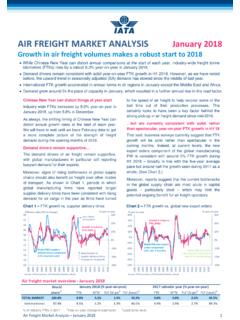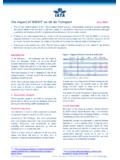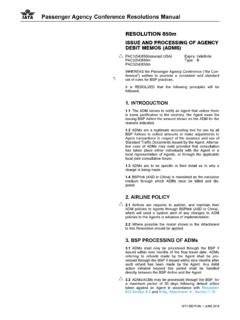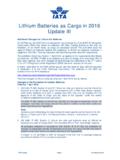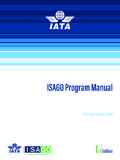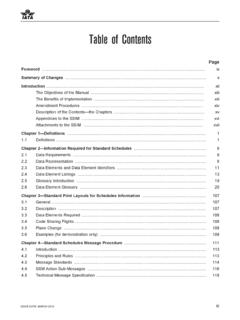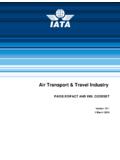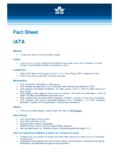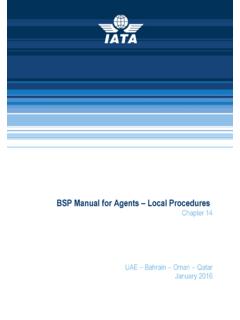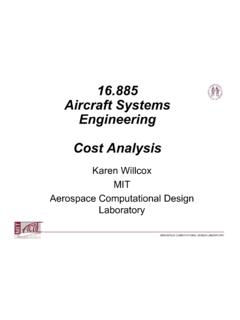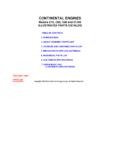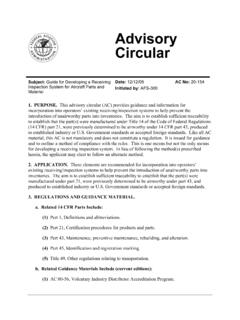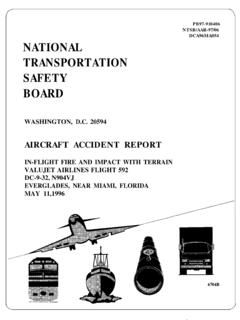Transcription of Maintenance Costs for Aging Aircraft
1 Maintenance Costs for Aging Aircraft20181st EditionMaintenance Costs for Aging Aircraft , 1st editionISBN 978-92-9229-637-7 2018 International Air Transport Association. All rights GenevaNOTICEDISCLAIMER. The information contained in this publication is subject to constant review in the light of changing government requirements and regulations. No subscriber or other reader should act on the basis of any such information without referring to applicable laws and regulations and/or without taking appropriate professional ad-vice. Although every effort has been made to ensure accuracy, the International Air Transport Association shall not be held responsible for any loss or damage caused by errors, omissions, mis-prints or misinterpretation of the contents hereof.
2 Furthermore, the International Air Transport As-sociation expressly disclaims any and all liabil-ity to any person or entity, whether a purchaser of this publication or not, in respect of anything done or omitted, and the consequences of any-thing done or omitted, by any such person or en-tity in reliance on the contents of this expressed in advertisements appearing in this publication are the advertiser s opinions and do not necessarily reflect those of IATA. The mention of specific companies or products in advertisement does not imply that they are endorsed or recom-mended by IATA in preference to others of a simi-lar nature which are not mentioned or advertised.
3 International Air Transport Association. All Rights Reserved. No part of this publication may be reproduced, recast, reformatted or trans-mitted in any form by any means, electronic or mechanical, including photocopying, record-ing or any information storage and retrieval sys-tem, without the prior written permission from:Vice-PresidentSafety and Filight OperationsInternational Air Transport Association800 Place VictoriaMontreal, QuebecCANADA H4Z 1M1 1st Edition 2018 i Table of Contents Introduction .. 1 Section 1 Aging Defined .. 2 Section 2 Technical Aging ..2 Economic Aging .. 3 Financial Aging .
4 4 The Purposes of Technical, Economic and Financial Aging .. 4 Elements Affecting Aging .. 5 Section 3 Routine Maintenance .. 5 Non-Routine Maintenance .. 6 Airworthiness Directives and Service Bulletins .. 6 Challenges of Collecting Data .. 8 Section 4 Accuracy .. 8 Consistency .. 8 9 Operational Changes .. 9 Guidelines to Produce an Aging Curve .. 11 Section 5 Approach ..11 Guidelines .. 12 Using the Maintenance Information System .. 12 Step by Step Methodology .. 12 Glossary .. 16 Section 6 Contributors .. 17 Section 7 Maintenance Costs for Aging Aircraft ii 1st Edition 2018 INTENTIONALLY LEFT BLANK 1st Edition 2018 1 Introduction Section 1 Estimating the evolution of Maintenance Costs through the entire life of an Aircraft can be a challenge.
5 The purpose of this paper is to provide a standardized methodology for industry stakeholders to determine the long term impact of airframe Aging on Maintenance Costs . This publication defines three types of Aircraft Aging (technical, economic and financial), what factors can influence them, and how they can be measured. Various parameters influence Maintenance Costs , such as routine and non-routine Maintenance , service bulletins (SB) and airworthiness directives (AD). Quantifying the evolution of Maintenance Costs requires to collect data throughout the life of the airframe. Data accuracy and consistency are critical.
6 This document proposes an approach and guidelines to produce curves based on direct Maintenance Costs by tail number. This paper is intended for airline personnel in technical divisions, especially fleet managers, and cost control personnel. It is the first attempt to quantify the effect of Aging on Maintenance Costs ; therefore, any comments are encouraged, and will possibly be incorporated in a future revised edition. IATA s Maintenance Cost Task Force (MCTF) is the owner of this publication, which was written in collaboration with airlines and IATA strategic partners. Comments from other industry stakeholders are welcome at: Maintenance Costs for Aging Aircraft 2 1st Edition 2018 Aging Defined Section 2 It is necessary to define the term Aging to characterize the long term impact on Aircraft Maintenance Costs .
7 The following types of Aging are used for different purposes: Technical Aging Economic Aging Financial Aging Technical Aging Technical Aging is the inherent effect of age on the Aircraft over time. Materials degrade with time, and each Aircraft sub-assembly ages at its own rate depending on calendar time and flight hours and cycles. The total Aircraft s Aging is found by the combination of the Aging of all its individual components. Technical Aging is influenced by the following factors, which define the operator s context: Aircraft design, technology and material (aluminum, titanium, steel, ) Scope of the Maintenance (MPD, cabin, specific operator program, modifications) Maintenance program (check interval: block concept, semi or fully equalized) Maintenance planning: tasks packaging, out of phase tasks Maintenance and engineering: organization, staff, number of mechanics, shift Maintenance practices and policies Operating parameters.
8 Aircraft utilization (cyclic and hourly effects) and operations (network) Aircraft performance, reliability Geographical location (region) and operational environment (temperature, humidity, salt, dust, pollution, etc.) The following technical Aging parameters can be measured: Number of Routine tasks Routine MHs Number of Non-Routine tasks Non-Routine MHs Finding rates Part replacement rates Grounding time (A/C operational availability) Aging Defined 1st Edition 2018 3 Based on the operator s context, technical Aging can be characterized by generating some profiles of the measured parameters over time. As a result, for a specific Aircraft type, technical Aging may vary depending on the operator s context, leading to dispersion in the results.
9 Certain operator's decisions affect overall Aircraft work. These decisions are not directly linked to technical Aging ; however, many times, it is not easy to segregate them from other activities. Such examples include: Aircraft leasing (especially related to lease return conditions and, in certain cases, to operational/ Maintenance conditions), marketing, etc. Economic Aging Economic Aging is the inherent effect of age on the Aircraft over time factored by economic data. The cost of the Maintenance is paid at the time that each Maintenance event occurs. Economic Aging = Technical Aging (operator context) $ Economic Aging is influenced by the following factors: Maintenance market and geographical region of the Maintenance activities Labor rates Labor efficiencies Economic conditions, such as price escalations and exchange rates Make-or-Buy policy: in-house/subcontracted, Time & material , Power By the Hour Contracts (when Maintenance is sub-contracted: man-hour caps, material caps, reduction factors) The following economic Aging parameters can be measured over time: Labor Costs material and inventory-related Costs In-house, subcontracted Costs Maintenance Costs by segment.
10 Line, Base, Heavy, Components, Engine Total Aircraft Maintenance Costs Based on a set of economic factors, the economic Aging can be characterized by generating Maintenance event cash flows of the measured parameters over time. These economic factors generate further dispersion in the results. Maintenance Costs for Aging Aircraft 4 1st Edition 2018 Financial Aging When the Maintenance Costs are not paid at the time that the Maintenance event occurs, they may be provisioned. Financial Aging is the method used to account for these provisions. Financial Aging is influenced by various factors such as: Operator financial policy Profit and loss Accounting system Budget The following financial Aging parameters can be measured over time: Provision for labor Costs , material Costs Provision for routine Costs , non-routine Costs Provision for Maintenance Costs by segment: line, base, heavy, components, engine Provision for in-house, subcontracted Costs There are as many financial Aging profiles as financial policies, resulting in as many different cash flow distributions over the Aircraft life.
